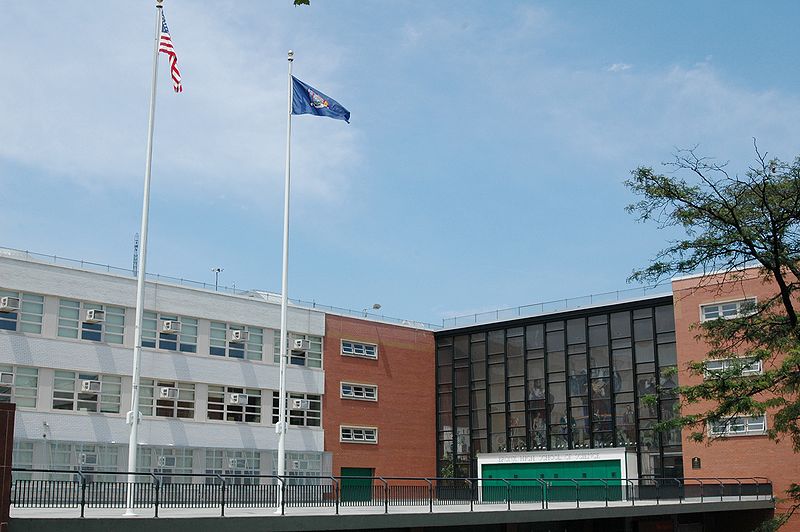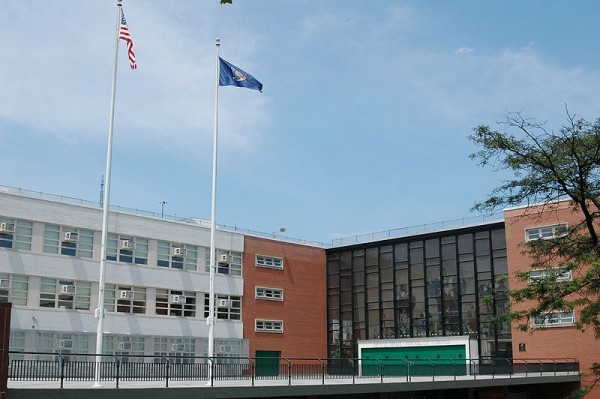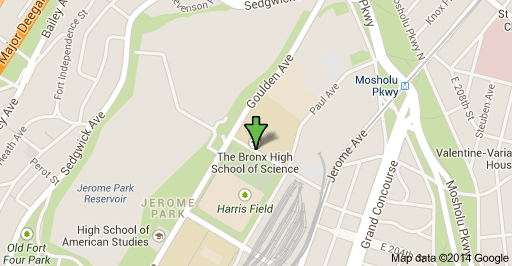
Top 100 Best High Schools 2013 – The Bronx High School of Science – Newsweek – 37/100
Top 100 Best High Schools 2013 – The Bronx High School of Science – Newsweek – 37/100
The Bronx High School of Science
The Bronx High School of Science (commonly called Bronx Science or Science, formerly Science High,[4][5] demonym “Scienceite(s)”[6]) is a specialized New York City public high school often considered the premier science magnet school in the United States. Founded in 1938, it is now located in the Bedford Park section of the Bronx. Admission is by an exam open to all grade-eligible students in New York City, reportedly taken by more than 20,000 students annually.[7] Although known for its focus on mathematics and science, Bronx Science also emphasizes the humanities and social sciences and continually attracts students with a wide variety of interests beyond math and science.
75 W 205th St, New York, NY 10468, United States
Local Map
Bronx Science has received international recognition[8] as one of the best[9] high schools in the United States, public or private, ranking in the top 100 in U.S. News and World Report’s lists of America’s “Gold-Medal” high schools in 2008 and 2009.[10] It attracts an intellectually gifted blend of culturally, ethnically,[11][12] and economically diverse students from New York City.[13] As of 2012, Bronx Science is ranked as one of the ” 22 top-performing schools”[14] in America on The Washington Post as well as number 50 out of a list of the best 1,000 high schools in the country on The Daily Beast’s “America’s Best High Schools”[15] list.
Every year almost all Bronx Science graduates go on to four-year colleges; many attend Ivy League and other prestigious schools.[16] Bronx Science has counted 132 finalists in the Intel (formerly Westinghouse) Science Talent Search, the largest number of any high school.[17] Eight graduates have won Nobel Prizes—more than any other secondary education institution in the United States[18]—and six have won Pulitzer Prizes.[19][20] Of the eight Nobel Prizes earned by Bronx Science graduates, seven of them are in physics, which earned Bronx Science a designation by the American Physical Society as an “Historic Physics Site” in 2010.
Bronx Science is a member of the National Consortium for Specialized Secondary Schools of Mathematics, Science and Technology (NCSSSMST).[23] Together with Stuyvesant High School and Brooklyn Technical High School, it is one of three original specialized science high schools operated by the New York City Department of Education.
Facilities and resources
Computerized & renovated science laboratories, including the Syracuse University @ Bronx Science Crime Lab and DNA Research Lab
Computer laboratories
Weather Station
Rooftop planetarium
2 rooftop greenhouses
Rooftop solar array: A rooftop solar panel installation was completed in February 2006. The 33.6 kW (DC) photovoltaic (PV) arrays consist of 168 Sharp Solar 200 watt DC PV modules laminated to PowerLight’s flat-roof PowerGuard mounting system and utilizes a Xantrex PV-30208 30 kW AC 3 phase inverter. Integration with the school’s computer network allows students to monitor the solar panels’ production of electricity in real time, while saving on the school’s energy cost. A screen just off the main lobby displays production data at every moment.[37]
High speed internet access in every room
Website with a .edu top-level domain, one of a few obtained by high schools before the rules changed in October 2001 restricting .edu to post-secondary schools.[38]
Televisions equipped with DVD/VHS players in every room
Advanced library resources:[39]The Bronx Science library provides resources ranging from traditional print and microform to electronic subscription e-journals and databases. Located on the first floor just off the main lobby, the library is composed of three smaller rooms encompassing approximately 65,000 square feet (6,000 m²) with a seating capacity of 100. Holdings include over 30,000 volumes, 135 different magazines, microforms (including the New York Times on microfilm dating back to 1851) and readers, and computers in the computer room. Among its electronic resources is ScienceDirect, a free science journal service provided by Elsevier to a select few science high schools. It is used by students as a gateway to firsthand experience with published scientific research.[40]
Foreign Language Multimedia Learning Center
Distance Learning Lab
Animal Room
Harris Field-a 15-acre (61,000 m2) field across 205th street where many Bronx Science sports teams practice.
Holocaust Museum and Studies Center
n 1978, Stuart S. Elenko, a Social Studies faculty member, founded a Holocaust Museum and Studies Center at Bronx Science, funded by grants, donations, and the New York City Council. The museum was one of the first of its kind in the United States, and houses a collection of rare documents, photographs, artifacts and other material from the Nazi era; the Studies Center sponsors speakers and puts together and distributes educational materials about the Holocaust. The museum has had over 60,000 visitors. In 2004 an anonymous benefactor – an alumnus of the school – made a very large donation to the museum. In 2006, the museum moved out of its original home into a larger space, although plans were made for the museum to be renovated. In April 2013, after more than a decade, Bronx Science completed the expensive job of rebuilding the newly redesigned museum – which now sits in the basement of the school. Costing over $1 million thanks to several grants and numerous donations from alumni (including $150,000 from the City Council) – over $500,000 of those expenses directed towards the museum’s construction – the museum is one of the rarest of its kind to be located in a public high school in America.[42][43] Home to over 1,000 collected artifacts, the museum is housed in a 1,000-square-foot (93 m2) room, which sports an aggregation of artifacts tucked in pull-out drawers and positioned beneath glass displays, along with their respective captions. [42][43] Bronx Science offers a Holocaust Leadership Class (offered to sophomores and upperclassmen), which allows the students in this class to serve as the tour guides of the Holocaust Museum & Studies Center.
Academics
Bronx Science students take a college preparatory curriculum that includes four years of lab science, math, English, social studies, two or three years of foreign language and a year of fine arts, with required courses and a wide selection of electives, including advanced placement (AP) classes, which allow students to place out of introductory college science courses. Over 160 distinct courses are offered.[45] Students have an opportunity to do independent research, and many compete in the annual Intel Science Talent Search (formerly sponsored by Westinghouse).
In the biological sciences, the students have the additional option of taking a special “double honors” biology course, which features extra laboratory exposure. Science electives include microbiology, physiology, forensic science, human genetics, evolution, astronomy, organic chemistry, electronics and others.
The mathematics department offers the standard AP courses in AB/BC calculus and statistics, courses in multivariable calculus and computer science, including AP Java. A course in linear algebra and differential equations was offered for the first time in fall 2007.
Students take four years of English, with electives including honors creative writing, exploring science fiction, journalism workshop and AP English.
Four years of social studies or history classes are required, and include US and world history, economics – with electives in psychology, law, finance, and global studies, among others.
Three years of languages are required. Bronx Science offers French, Spanish, Latin, Italian, Modern Greek, Chinese, Japanese, and Korean. At one time Hebrew, Russian and German were also offered.
Students in their sophomore year are required to take either Applied Science or a class to satisfy the Sophomore Research Requirement. Classes that satisfy the Sophomore Research Requirement include Introduction to Engineering, Social Science Research, Biology/Physical Science Research, and Math Research.[46] Students have the option of continuing their research in their junior and senior years, which gives them the opportunity to work with mentors and submit their final research paper to prestigious competitions such as the Intel Science Talent Search.[46] Students must also obtain credits from two terms of a class in the fine arts or the equivalent. The fine arts requirement is usually satisfied during Bronx Science’s Summer Program which offers Drama, Music, and Art.[46] Students usually “double up” on two of these courses to satisfy the fine arts requirement for once and all during the time period of one summer. However, it is possible to satisfy the fine arts requirement by taking a music elective such as Jazz Band or an arts elective such as AP Studio Art during the regular school year.[46]
Health and Physical Education courses are also required, with activities including step aerobics, weight training, basketball, skating, team handball, fitness and yoga.


